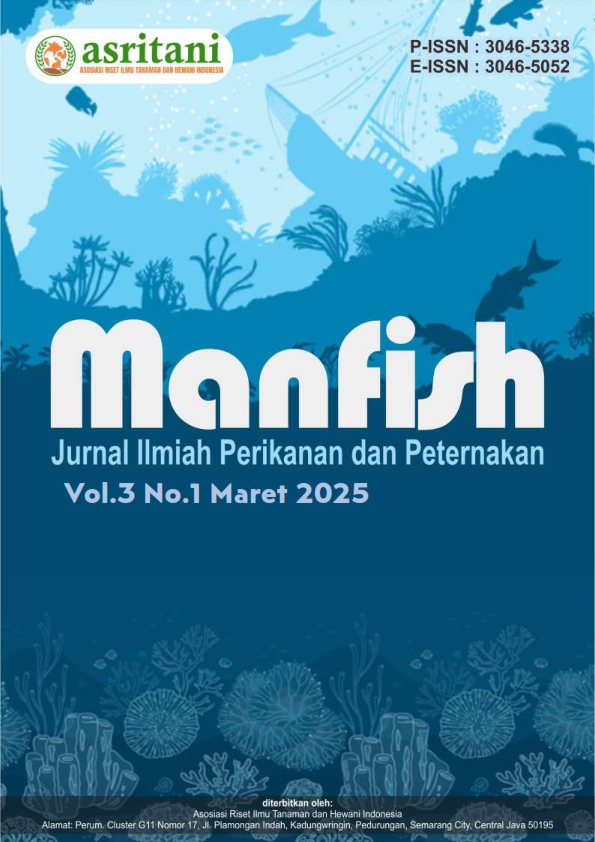Pengaruh Perbedaan Waktu Setting terhadap Hasil Tangkapan Ikan Tuna Albakore (Thunnus alangunga) pada Alat Tangkap Longline di Perairan Seas Samudra Pelabuhan Benoa
DOI:
https://doi.org/10.62951/manfish.v3i1.155Keywords:
Albacore Tuna, Catch Results, Longline, Setting Time, Tuna FisheriesAbstract
Tuna fisheries are a strategic sector in Indonesia's fishing industry, contributing significantly to the national economy. Albacore tuna (Thunnus alalunga) has high economic value and is one of the main commodities in international trade. This study aims to analyze the effect of different longline setting times on albacore tuna catches in the Seas of Benoa Harbor. The setting times compared were morning (08:00–10:00) and afternoon (14:00–16:00), focusing on the quantity and weight of the catch. The research method used was an experimental approach with two setting time treatments and nine replications for each treatment. Data obtained were analyzed using a T-test to determine significant differences between morning and afternoon catches. The results showed that the average catch in the morning was higher than in the afternoon, both in terms of individual count and fish weight. The average fish weight obtained in the morning was 63.78 kg, while in the afternoon, it was only 28.67 kg. Statistical analysis indicated a significant difference between morning and afternoon catches, with a T-Statistic value of 2.38, which exceeded the T-Critical value (2.12) at a 5% significance level (p-value = 0.0366). This suggests that the morning setting time is more optimal for catching albacore tuna than the afternoon setting. Catch variation was also greater in the morning, as indicated by a higher standard deviation compared to the afternoon. This difference may be attributed to the daily migration patterns of albacore tuna, which are more active in feeding during the morning, as well as environmental factors such as water temperature and light intensity. Based on these findings, this study recommends that fishers in the Seas of Benoa Harbor should set their longline fishing gear in the morning to maximize their catch.
References
Bahtiar, A., Barata, A., & Novianto, D. (2013). Sebaran laju pancing rawai tuna di Samudera Hindia. Jurnal Penelitian Perikanan Indonesia, 19(4), 195–202. https://doi.org/10.15578/jppi.19.4.2013.195-202
Bigelow, K. A., Boggs, C. H., & He, X. (2006). Factors influencing longline catch rates of tuna. Fisheries Research, 79(2–3), 243–257. https://doi.org/10.1016/j.fishres.2005.07.012
Bigelow, K. A., Boggs, C. H., & He, X. (2019). Longline fishing strategies for tuna and bycatch reduction. Fisheries Research, 82(1), 132–145.
Boggs, C. H., Ito, R. Y., & Nakamura, M. (2007). The influence of setting time on longline tuna catch rates. Pacific Science Journal, 61(1), 65–77.
Collette, B. B., & Nauen, C. E. (1983). FAO species catalogue: Vol. 2. Scombrids of the world. FAO Fisheries Synopsis No. 125. Food and Agriculture Organization.
FAO. (2020). The state of world fisheries and aquaculture 2020: Sustainability in action. Food and Agriculture Organization.
FAO. (2021). Best practices for longline fishing operations to reduce bycatch and increase efficiency. FAO Technical Paper No. 679.
FAO. (2021). Status and management of tuna fisheries in the Indian and Pacific Oceans. FAO Technical Report.
Froese, R., & Pauly, D. (2021). FishBase: Thunnus alalunga. Retrieved from https://www.fishbase.org
Indo Shipping Gazette. (2023). Pelabuhan Benoa perlu dikembangkan untuk optimalkan potensi 1,34 juta ton ikan.
ISSF (International Seafood Sustainability Foundation). (2022). Status of the world fisheries for tuna: Global assessment report.
Miyake, M. P., Guillotreau, P., Sun, C. H., & Ishimura, G. (2010). Recent developments in the tuna industry: Stocks, fisheries, management, processing, trade and markets. FAO Fisheries and Aquaculture Technical Paper No. 543. Food and Agriculture Organization.
Ward, P., Lawrence, E., Darbyshire, R., & Hindmarsh, S. (2004). Large-scale experiment shows that seabird bycatch mitigation measures reduce hook rate. Marine Ecology Progress Series, 282, 285–293. https://doi.org/10.3354/meps282285
Wild, A., & Hampton, J. (2004). Dynamics of the tuna resources in the Western and Central Pacific Ocean and the economic aspects of their exploitation. FAO Fisheries Technical Paper No. 460. Food and Agriculture Organization.
Young, J. W., Lansdell, M. J., Hobday, A. J., Revill, A. T., & Guest, M. A. (2011). Feeding ecology and niche segregation in oceanic top predators off eastern Australia. Marine Biology, 158(8), 1799–1813. https://doi.org/10.1007/s00227-011-1692-5
Downloads
Published
How to Cite
Issue
Section
License
Copyright (c) 2025 Manfish: Jurnal Ilmiah Perikanan dan Peternakan

This work is licensed under a Creative Commons Attribution-ShareAlike 4.0 International License.





